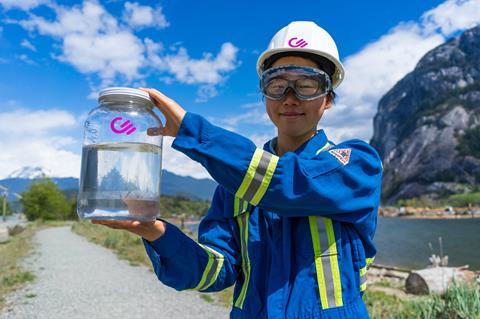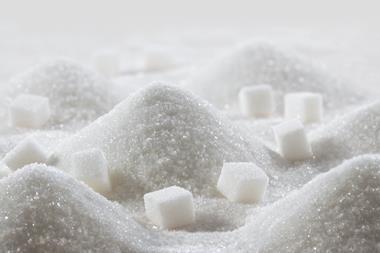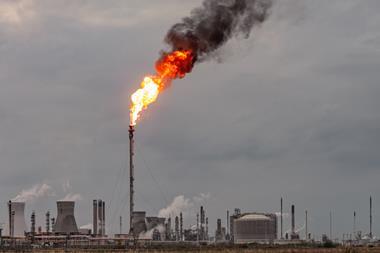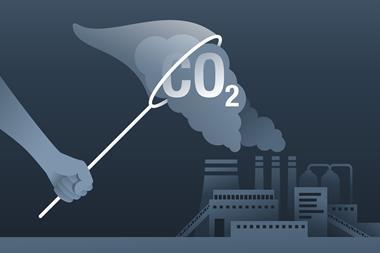Angeli Mehta finds out if we can make jet fuel sustainably – and cheaply
There’s a horrible irony: just as commercial scale sustainable aviation fuel projects are within touching distance, the fallout from the Covid-19 pandemic leaves the airline industry haemorrhaging cash. No one knows how quickly or how far it will recover. But whatever happens, for the world to get to a net-zero-carbon economy by 2050 aviation will have to play its part.
So far only the French government has called for cuts in carbon emissions in return for a financial bailout of the country’s national carrier. The conditions include a commitment to source 2% of its fuel requirements from sustainable sources by 2025. The European Commission is looking at setting a minimum requirement for sustainable aviation fuels for all flights, while Norway introduced a 0.5% blending mandate in January.
We have a long way to go before guilt-free flying, but it is what we must achieve
Aeroplanes need high power output and energy-dense fuels, so the options for replacing today’s fossil-derived are limited. These options do exist, but they cost several times more than kerosene, and they’re not yet made in anything like the quantities the sector is going to require.
However, even in the midst of the current crisis, one of the pioneers of sustainable aviation fuel – LanzaTech – struck an investment arrangement borrowed from the pharmaceutical sector that could lead to multiple plants being built by the middle of the decade. Meanwhile, British Airways has continued to back waste-to-fuels business Velocys, advancing further capital as it does the detailed engineering design work on what will be the UK’s first sustainable aviation fuel plant – to be built on the Humber.
The inaugural meeting of the UK’s Jet Zero Council in July 2020 also ‘shows that Government and industry are taking the challenge of getting to net zero carbon aviation seriously, and it provides an opportunity to harness the country’s resources to meet it’, says Neville Hargreaves, vice president of waste to fuels at Velocys. Jennifer Holmgren, chief executive of LanzaTech, was also on at the virtual event: ‘They [ministers] were focused on jobs and they were focused on creating a different way of flying – they talked about guilt-free flying. To be honest we have a long way to go before that happens, but it is what we must achieve.’
Production pathways to make sustainable fuels from resources ranging from waste fat and oils to industrial off-gases have been agreed and certified, while the International Civil Aviation Organisation (ICAO) has developed methodologies to make life cycle assessments of their carbon impacts.
While they are technically ‘drop-in’ fuels that don’t require any changes to aircraft or infrastructure, so far they’re only permitted in blends of up to 50% with fossil kerosene. In the past 12 years, more than 200,000 flights have used some portion of them.
The fuels won’t decarbonise the airline industry – that awaits other advances. However, they can potentially make a big dent in life cycle emissions – up to 80% depending on the pathway. Moreover, they almost entirely eliminate sulfur and particulates – meaning less pollution, and potentially less aerosols that also impact climate.
Scaling up

It’s taken Lanzatech 15 years to be on the cusp of scale up. The company’s process relies on genetically modified bacteria to ferment industrial waste gases to make ethanol. Its first plant at a Chinese steel mill has made over 10 million gallons of fuel over the past two years. The ethanol can be upgraded to synthetic paraffinic kerosene. The thermo-catalytic process for this alcohol to jet platform was developed initially by the US Department of Energy’s Pacific Northwest National Laboratory: Lanzatech has taken it from lab to pilot scale. Both Virgin Atlantic and All Nippon Airways have tested the fuel in commercial flights.
Now a major investment package and the creation of LanzaJet, a spinout company, will allow a US demonstration facility to be built by early 2022, to produce 10 million gallons (38 million litres) of fuel. If all goes smoothly, the first three commercial facilities will be making 30 million gallons apiece by 2025. ‘Every process, every step has to be as efficient as possible and has to feed on itself, so that the whole is as efficient as possible. We spent years optimising it for scale up,’ explains Holmgren. ‘In my mind, the risk here is not whether we’ll be able to build a unit that works. I think the risk is how the economics of the process will work out – and it matters to an airline who buys a lot of fuel. You know 10 cents a gallon [two pence per litre] is not an insignificant number.’
Both parts of the LanzaTech process are flexible. Its microbe uses the water–gas shift reaction to make its own hydrogen, so it can handle a variety of carbon monoxide to hydrogen ratios, even where there’s no hydrogen available. The subsequent alcohol to jet pathway can take any sustainable ethanol – which opens up multiple sources to Lanzatech and should help develop capacity. ‘We wanted to drive a lower carbon, more sustainable ethanol world by creating the pull and the demand,’ says Holmgren. How much can Lanzatech make? Holmgren reckons industrial gases alone could make billions of gallons, and gasified municipal solid waste would add to that. And she has a dream for when renewable electricity is everywhere: ‘Can you imagine a direct air capture machine and an electrolysis unit and our unit on the back end? So the technology possibilities are endless … I like this solution because it doesn’t hit a wall.’
Another pioneer, Fulcrum Bioenergy, plans to have its plants near airports, which tend to be close to cities – and their waste. Commissioning of its municipal solid waste to fuel plant in the Nevada desert will begin later this year. Here, the waste will be gasified to produce syngas (a mix of hydrogen, oxygen and carbon monoxide), which is cleaned and converted into long chain hydrocarbons suitable for making jet fuel using the Fischer–Tropsch process. The reactor system has been designed by Johnson Matthey and BP, and is the culmination of a long collaboration. The breakthrough was a new process for BP’s catalyst to work in, and modification of the catalyst structure so it could function in the small can-shaped reaction vessels. ‘It’s not often you get a step change in the efficiency of 100 year old technology,’ says Eugene McKenna, Johnson Matthey’s business development and innovation director.
The Fischer–Tropsch process involves highly exothermic reactions, so it’s crucial to remove the heat to preserve the catalyst and maximise fuel production. Usually, scale is required to get efficiency, as demonstrated by the vast scale of Shell’s Qatar facility which also makes kerosene.
But not in the new reactor. ‘You reduce the amount of catalyst that’s required because it’s so efficient, you reduce the capital that’s required because you don’t need enormous thick steel walls on high pressure vessels, and you control the pressure drop. So you’ve got lower pressures, less steam, less capital, less carbon dioxide going into producing the product, so it becomes a virtuous circle,’ explains McKenna.
Reduce, reuse, recycle
Velocys is also banking on Fischer–Tropsch innovations to develop sustainable aviation fuel plants in the UK and US. The reactor architecture came out of work done at Pacific Northwest National Laboratory aimed at making chemicals in space – although Velocys only has the terrestrial license. Hargreaves claims Velocys’ cobalt catalyst is the most active available, in terms of conversion per volume of catalyst – and the particle structure is key. That advance came out of Oxford University spinout Oxford Catalysts, and was the forerunner to Velocys.

‘None of this stuff is easy,’ says Hargreaves ‘but it’s using technology that is already available and commercial. So what we’re doing is knitting together individual technologies rather than having to do new, blue sky research.’
The proposed plant in Mississippi will take waste woody biomass from fast-growing plantations – parts of trees not suitable for timber, as well as thinnings and sawdust. ‘We’ve thought pretty carefully on that – we’re genuinely removing waste material and not displacing other uses of the wood,’ he stresses. The carbon dioxide produced in the process of making fuel will be captured and stored in underground geological storage. Hargreaves argues that solution could be replicated at its UK plant – to be built at Immingham in Lincolnshire on the Humber estuary. ‘The Humber is promoting itself as the energy estuary of the UK with not only offshore wind, but also efforts to decarbonise existing industry, and obviously it’s a potential hub for carbon capture and storage. We’re part of that story because we produce a by-product stream of carbon dioxide suitable for capture, so we’re bringing a new industry to take advantage of carbon capture and storage infrastructure. I think the more we can do that as a country, the better chance we have of meeting net zero targets.’
Velocys calculates a 70% reduction in lifecycle carbon emissions for its fuel made from woody biomass. However a ‘fair mechanism’ to determine what figure can be claimed for the non-biogenic portion of municipal solid waste (like rubber or plastics) hasn’t yet been established by the Department for Transport. Hargreaves hopes it will be available later this year. Nonetheless, he is confident that there are ‘considerable carbon savings’ to be had from making fuel from the waste rather than either burning it or sending it to landfill – both of which will release greenhouse gases.
The intention is that Shell and BA will take the fuel – enough for 1000 transatlantic flights each year – produced from around half a million tonnes of waste. Since the UK exports or landfills 10–15 million tonnes each year, there’s potential for more plants.
We can show the molecules are identical to the ones found in aviation fuel
Getting to the engineering design stage of the Immingham plant has depended on both government financial backing and – crucially – a policy framework. BA’s previous venture with Solena (also to make fuels from household waste) foundered at a time of low oil prices and its exclusion from the UK’s Renewable Transport Fuel Obligation – a mechanism that requires transport fuel suppliers to source a percentage of their fuel from renewable sources. Lanzatech also wants to build plants in the UK, but its carbon recycling technology isn’t yet included within the RTFO framework. At EU level, consultations are underway on the methodology to be used to calculate the greenhouse gas emission reduction achieved by such fuels.
Forests and fats to fuels
In Sweden a younger company, Renfuel, calculates its fuels will provide at least a 70% reduction in carbon emissions. Renfuel has developed a process to turn lignin – which forms around 30% of the cell walls of trees – into a liquid oil it calls Lignol. Joseph Samec, a professor of chemistry at Stockholm University and founder of Renfuel, says there’s the potential to extract millions of tonnes of forest residues (while leaving enough to restore soil carbon) to produce lignin, as well as taking lignin produced by the pulp and paper industry. Here only a fraction of the 5 million tonnes generated each year is burned to provide process energy, leaving a potentially valuable resource untapped.

However, this form of lignin – a technical lignin called kraft lignin – poses a challenge as it is much more highly condensed than its natural form. Instead of having carbon–oxygen bonds that can be broken easily, it has many carbon–carbon bonds. To process kraft lignin in a separate refinery would be uneconomic, says Samec, but Renfuel ‘borrows’ vegetable oils being used in a nearby bio-refinery to esterify the lignin, and then provides both to the refinery processes to make renewable road transport fuel.
‘We can show the molecules are identical to the ones found in aviation fuel. But that’s still not enough. You have to standardise it. And that’s a pretty long process. So that is what we are working on now,’ explains Samec. The European Investment Bank has just agreed to back Renfuel’s project to develop a lignin plant at a Swedish pulp mill, with a capacity of 185,000 tonnes of lignol. Samec estimates that using lignin from Swedish forests and pulp mills could make the country a net exporter of transport fuel.
Waste oils and fats form a well-developed pathway to making aviation fuels. These have been produced in the US by what is now World Energy, and in Europe by Finnish producer Neste, for several years. Now SkyNRG – set up by a consortium that included Dutch airline KLM – is planning its first facility to turn waste oils (like cooking oil) into renewable fuel.
But it will need a source of hydrogen. A project at Delfzijl in the Netherlands will use so-called green hydrogen, made by the electrolysis of water. Industrial chemicals group Nouryon, and the Dutch gas network operator Gasunie are looking at tripling the size of a proposed 20MW facility to meet the anticipated demand from SkyNRG. ‘We just need more of these projects, and [to get] those projects to scale,’ says Oskar Meijerink, project lead for future fuels.
Indeed, SkyNRG has its eye on pairing green hydrogen with carbon from industrial waste gases (as in Lanzatech’s approach) or from direct air capture. And green hydrogen scale-up is crucial for a synthetic fuels pathway, where it must deliver the energy to the process. ‘The amount of hydrogen needed for a synthetic fuels pathway is way higher than for a bio-refinery. So then it becomes the driving force – while today in the bio-refineries it’s a utility so to speak,’ Meijerink explains. ‘Carbon dioxide from industrial sources makes a lot of sense in scaling that pathway, but I really believe the endgame is direct air capture – certainly towards 2050 when we need negative emissions, we will need those technologies.’
SkyNRG is exploring a small scale (200 tonnes a year) synthetic fuel plant with Swiss direct air capture pioneer, Clime Works. The process would involve conversion of carbon dioxide to monoxide either by electrolysis or water–gas shift. The other advantage of this approach is that the resulting syngas would be very pure meaning it would work well in a Fischer–Tropsch process, as no clean-up stage would be required.
If such a process could be scaled, its attraction would be in locking the carbon dioxide from aircraft emissions into a continuous use–reuse cycle. Other groups around the world are also working on direct air capture to make fuel. Whether it could be scaled up enough – and the energy requirements to achieve that scale-up met – remains for now a subject for computer modelling.
Holmgren hopes that she and others are on the verge of getting beyond the one-off pilot or demonstration facility that can’t be scaled. ‘Somehow policy has to help us scale. It’s that simple. I don’t think policy makers are thinking about the collaboration that’s required, and the fact that there’s room for all of us because, quite frankly, if we don’t all succeed, the problem is way bigger – we all need to win.’
In a world before Covid-19, the International Energy Agency estimated aviation emissions were growing by around 2% each year, and almost 400 million tonnes of jet fuel was being consumed. Demand is predicted to be 25% lower on average this year, but that’s still a huge volume of fuel that has to be replaced by something more sustainable.
Angeli Mehta is a science writer based in Edinburgh, UK













No comments yet